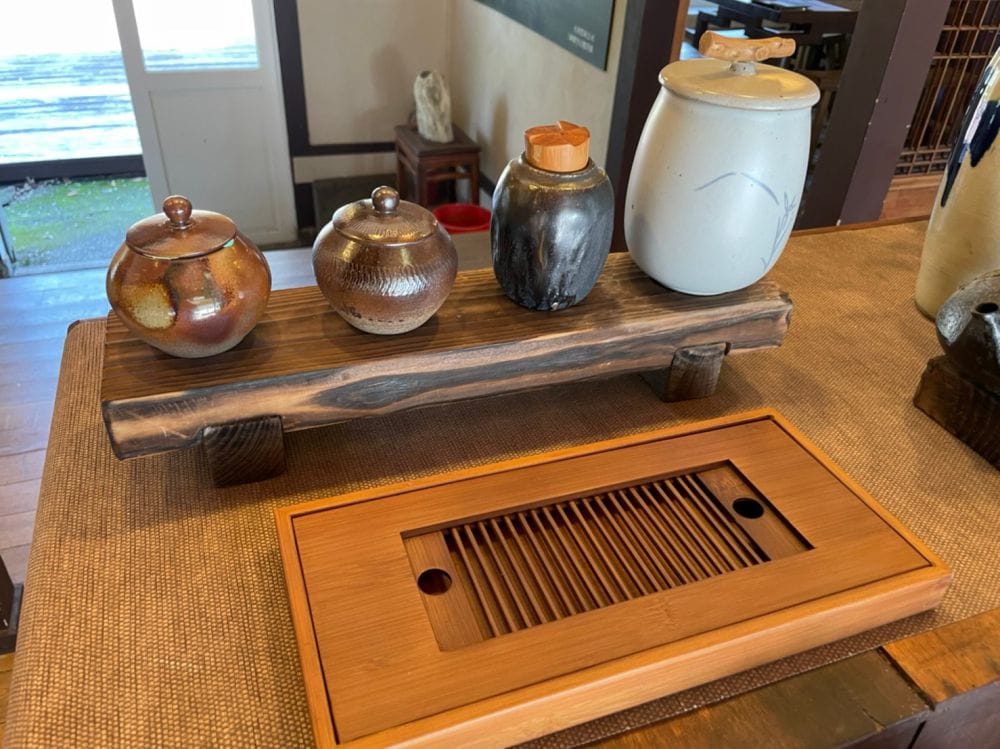Amidst the pandemic’s tension, I’ve heard that tea offers health benefits and boosts immunity. Today, with my husband free and our car ready, we set off on a weekday escapade to avoid crowds. Our destination? The scenic surroundings of Sanxia, close to our home. And there, nestled in the heart of Taiwan’s cultural charm, we stumbled upon the delightful Musashino Tea House, a harmonious blend of Taiwanese and Japanese aesthetics.

Surprisingly, this place was the predecessor of Taiwan’s Forestry Bureau – the ‘Nippon Mitsui Joint-Name Association.’ In 1899, this company established a base in Taiwan to expand its tea plantations. In 1924, they named this location the ‘Daliao Tea Plantation’ and collaborated extensively with local tea farmers to cultivate Assam tea trees. This venture became renowned and played a pioneering role in exporting Taiwanese black tea to Japan.

In 1944, the Japanese chose this land and built a traditional wooden house with earthen walls, which served as the former residence of the plantation manager. Recently, Taiwan’s Provincial Department of Agriculture and Forestry renovated this historic house as part of the ‘New Taipei City Industrial Tourism Development Project.

This historic site, once the residence of the Japanese plantation manager, now stands as Taiwan’s Forestry Bureau’s northern refined tea factory. Its ancient tree at the entrance, a silent witness to time, adds to the serene ambiance.

The circular window design follows ancient techniques for restoration, faithfully preserving the distinctive architectural features of the Showa era.

The black tiles, resembling fish scales, elegantly adorn the roof, offering both excellent waterproofing and insulation. It’s rare to find such traditional Japanese-style houses in Taiwan today that still retain this unique architectural feature.

The exterior of the second building has meticulously preserved the simple and rustic charm of its original cobblestone walls.

The interior evokes the essence of Japanese aesthetics, blending simplicity, elegance, and a sense of history. They are not merely functional; they carry the spirit of craftsmanship and cultural heritage.

The interior walls have been transformed with floor-to-ceiling windows, allowing natural light to flood in. Against the backdrop of distant mountains, this creates the most serene and organic ambiance.

Surrounded by towering trees, the exterior of this Japanese-style tea house exudes tranquilityGentle breezes playfully dance around, and expansive mountain views unfold in every direction.

From a century’s worth of significant events to a map displaying the distribution of tea factories across the island, and even detailed introductions to organic tea gardens, it’s all meticulously presented.

I absolutely adore these sun-drenched, floor-to-ceiling windows! They don’t just brighten the room; they instantly lift the spirits and provide the gentlest, most natural illumination. Unbeknownst to me, they beautifully complement the entire wooden decor with a touch of antiquity.

Delving into the depths, one can unearth nostalgic relics from childhood – like weathered wooden cabinets adorned with ancient grain patterns or low, elongated tables. These remnants evoke memories of simpler times, connecting us to the past through their rustic charm.

The vintage pendulum clock, steeped in nostalgia, retains its simple, timeless charm. Rather than fading into oblivion with changing times, it now holds a soothing significance for the soul.

Especially after exploring the exhibits, you can savor the aroma of tea inside the ancient house, embarking on a cultural and aesthetic journey like no other.

ea ceremony, originating in China, has evolved into a distinctive cultural practice. Its history dates back to the 13th century when Buddhist monks brought both Buddhism and tea to Japan during the Tang Dynasty. In modern tea ceremonies, the host meticulously prepares tea and sweets for guests, adhering to fixed rules and steps.

Savoring tea, inhaling its fragrance, and tasting the essence of time during the brewing process—these moments offer a serene refuge for the mind and soul. It’s not merely a nostalgic memory; it’s an embodiment of the tranquil aesthetics that tea culture brings to life.

Push open a white wooden door—sipping tea, then rising to explore, you turn a corner within the tea house, and suddenly, it’s like stepping into a different world. Every nook and cranny holds delightful surprises!

In the center, as you move toward the back, another hidden paradise unfolds—a view of distant mountains and nearby forests. And take note of the design elements: elevated foundations, ventilation windows, and large window panes. These features serve to protect against Taiwan’s humid climate and prevent infestations by pests.

The house features specially crafted sliding doors in the style of traditional Japanese bungalows. This design enhances the flow between indoor and outdoor spaces, ensuring the entire building remains dry and optimally ventilated.

We ordered a pot of Oriental Beauty and Silver Needle Oolong, accompanied by mini pineapple cakes in three flavors as tea snacks. Tea culture flows naturally within me, unburdened by rigid rules or fixed steps. I simply relax, savor, inhale, and let my spirit absorb the moment.

The ambiance of tea ceremony encompasses various essential elements, including the arrangement of tea rooms, tea utensils for tasting, the layout of tea-tasting spaces, calligraphy and painting art, meticulously tended gardens, and ceramic teaware. These components collectively elevate the tea experience to a state of fulfillment and harmony.

When material fails to satisfy the soul, we often seek a more spiritual and cultural level. Why not immerse yourself in a half-day tea ceremony experience in the countryside?
